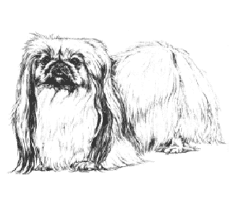Pekingese
General Information - Pekingese

Group:
Toy
Size:
Small
Lifespan:
13-15 years
Exercise:
Very little
Grooming:
Very high
Trainability:
Very hard
Watchdog Ability:
Very high
Protection Ability:
Very low
Area of Origin:
China
Date of Origin:
Ancient times
Other Names:
Lion Dog, Peking
Palasthund
Original Function:
Lapdog
History
Pekingese where regarded as manifestation of the legendary Foo Dog that drove away spirits. They were venerated as semi-divine by the Chinese. Commoners had to bow to them, and were punished by death if they stole one. At the height of their favour (during the T'ang Dynasty from A.D. 700 to A.D. 1000) many of these Lion Dogs were literally treated as royalty, pampered by personal servants. Smaller Pekingese were called sleeve dogs because they could be carried in the large sleeves of their Chinese masters. When an emperor died, his Pekingese were sacrificed so that they could go with him to give protection in the afterlife. In 1860 the Pekingese reached the West. British and French troops overran the Imperial Summer Palace during the Second Opium War. Imperial Guards were ordered to kill the little dogs to prevent them from falling into the hands of the "foreign devils," but five Pekingese survived and were taken to Queen Victoria, who named appropriately, Looty. It is from these canine spoils of war that the modern Pekingese is descended.
Temperament
The Pekingese is a very controlling dog breed and often does not understand who is the master of the house. The Pekingese can be difficult to housebreak. Very suspicious of strangers, this dog breed makes an excellent watchdog. It is known to be stubborn.
Upkeep
The Pekingese enjoys a leisurely walk outdoors, but it is equally happy to romp inside. It can easily die of heat prostration. It must be kept cool in warm weather. It can spend time outside in cool weather, but it should sleep inside. It is an ideal apartment dog. The coat will mat unless combed at the very least weekly, preferably more often. The over-nose wrinkle should be cleaned daily to avoid infection. The coat around the rear must be inspected daily for soiling. Pekingese tend to snore!
Pekingese
A breed standard is the guideline which describes the ideal characteristics, temperament, and appearance of a breed and ensures that the breed is fit for function with soundness essential. Breeders and judges should at all times be careful to avoid obvious conditions and exaggerations, as well as being mindful of features which could be detrimental in any way to the health, welfare or soundness of this breed.
Breed Standard - Pekingese
 General Appearance:
General Appearance: Should be a small, well-balanced, thickset dog of great dignity and quality. He should carry himself fearlessly in the ring with an alert, intelligent expression.
Head and Skull: Head massive, skull broad, wide and flat between the ears, not domed; wide between eyes. Nose very short and broad, nostrils large, open, and black; muzzle wide, well wrinkled, with firm underjaw. Profile should look quite flat with nose well up between the eyes. Deep stop.
Eyes: Large, round, clear, dark and lustrous.
Ears: Heart-shaped, set level with the skull and carried close to the head. Long profuse feathering on ears. Leather not to come below the muzzle.
Mouth: Level lips, must not show teeth or tongue.
Neck: Very short and thick.
Forequarters: Short, thick, heavily-boned forelegs; bones of forelegs bowed but firm at shoulder. Absolute soundness essential.
Body: Short but with broad chest and good spring of rib, falling away lighter behind; lion-like with distinct waist, level back; well slung between the legs, not on top of them.
Hindquarters: Hind legs lighter but firm and well shaped. Close behind but not cow-hocked. Absolute soundness essential .
Feet: Large and flat, not round. The dog should stand well up on feet, not on pasterns. Front feet turned slightly out. Absolute soundness essential.
Gait: A slow dignified rolling gait in front, with a close gait behind, this typical movement not to be confused with a roll caused by slackness of shoulders.
Tail: Set high, carried tightly, slightly curved over back to either side. Long feathering.
Coat: Long and straight with profuse mane extending beyond the shoulders forming a cape or frill round the neck; top coat rather coarse, with thick undercoat. Profuse feathering on ears, legs, thighs, tail and toes.
Colour: All colours and markings are permissible and equally good, except albino or liver. Parti-colours should be evenly broken.
Weight and Size: The ideal weight of the Pekingese should not exceed 5 kg (11 lbs) for dogs and 5.5 kg ( 12 lbs) for bitches. The dog should look small but be surprisingly heavy when picked up; heavy bone and a sturdy well-built body are essentials of the breed.
Note: Male animals should have two apparently normal testicles fully descended into the scrotum.
DNZ No 152
Dogs New Zealand
01 Jan 2002
Any departure from the foregoing points should be considered a fault and the seriousness with which the fault should be regarded should be in exact proportion to its degree and its effect upon the health and welfare of the dog and on the dog’s ability to perform its traditional work.




